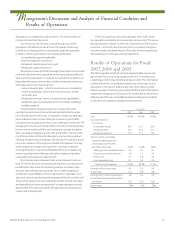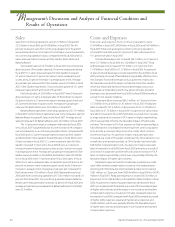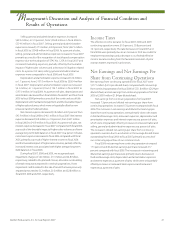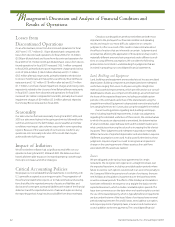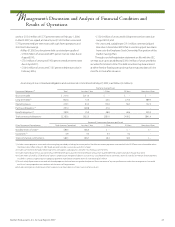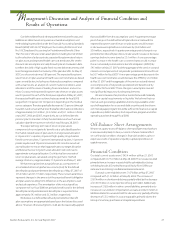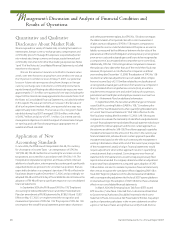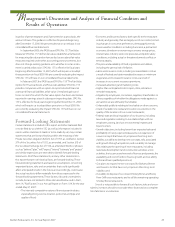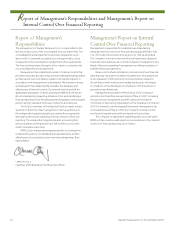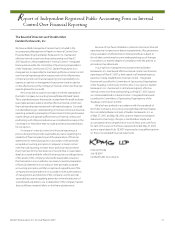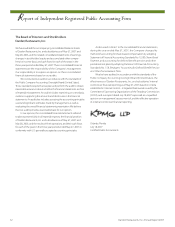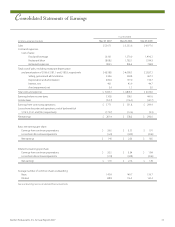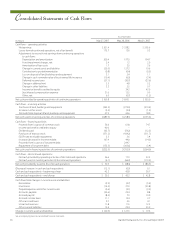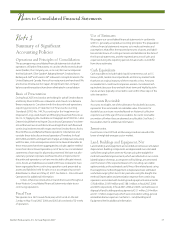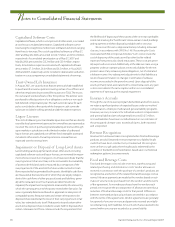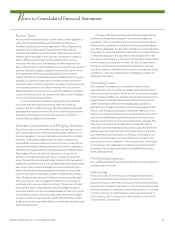Red Lobster 2007 Annual Report Download - page 31
Download and view the complete annual report
Please find page 31 of the 2007 Red Lobster annual report below. You can navigate through the pages in the report by either clicking on the pages listed below, or by using the keyword search tool below to find specific information within the annual report.
M
Darden Restaurants, Inc. Annual Report 2007 29
Management’s Discussion and Analysis of Financial Condition and
Results of Operations
its policy of presenting taxes and, if presented on a gross basis, the
amount of taxes. The guidance is effective for periods beginning
after December 15, 2006. We present sales tax on a net basis in our
consolidated financial statements.
In September 2006, the FASB issued SFAS No. 157, “Fair Value
Measures.” SFAS No. 157 defines fair value, establishes a framework
for measuring fair value and enhances disclosures about fair value
measures required under other accounting pronouncements, but
does not change existing guidance as to whether or not an instru-
ment is carried at fair value. SFAS No. 157 is effective for fiscal years
beginning after November 15, 2007, which will require us to adopt
these provisions in fiscal 2009. We are currently evaluating the impact
SFAS No. 157 will have on our consolidated financial statements.
In February 2007, the FASB issued SFAS No. 159 “The Fair Value
Option for Financial Assets and Financial Liabilities.” SFAS No. 159
provides companies with an option to report selected financial
assets and financial liabilities at fair value. Unrealized gains and
losses on items for which the fair value option has been elected are
reported in earnings at each subsequent reporting date. SFAS No.
159 is effective for fiscal years beginning after November 15, 2007,
which will require us to adopt these provisions in fiscal 2009. We
are currently evaluating the impact SFAS No. 159 will have on our
consolidated financial statements.
Forward-Looking Statements
Certain statements included in this report and other materials filed
or to be filed by us with the SEC (as well as information included in
oral or written statements made or to be made by us) may contain
statements that are forward-looking within the meaning of the
Private Securities Litigation Reform Act of 1995, as codified in Section
27A of the Securities Act of 1933, as amended, and Section 21E of
the Securities Exchange Act of 1934, as amended. Words or phrases
such as “believe,” “plan,” “will,” “expect,” “intend,” “estimate,” and “project”
and similar expressions are intended to identify forward-looking
statements. All of these statements, and any other statements in
this report that are not historical facts, are forward-looking. These
forward-looking statements are based on assumptions concerning
important factors, risks and uncertainties that could significantly
affect anticipated results in the future and, accordingly, could cause
the actual results to differ materially from those expressed in the
forward-looking statements. These factors, risks and uncertainties
include, but are not limited to those discussed below and in Part I,
Item 1A, “Risk Factors” in our Annual Report on Form 10-K for the year
ended May 27, 2007:
• The intensely competitive nature of the restaurant industry,
especially pricing, service, location, personnel and type and
quality of food;
• Economic and business factors, both specific to the restaurant
industry and generally, that are largely out of our control, includ-
ing changes in consumer preferences, demographic trends,
severe weather conditions including hurricanes, a protracted
economic slowdown or worsening economy, energy prices,
interest rates, industry-wide cost pressures and public safety
conditions, including actual or threatened armed conflicts or
terrorist attacks;
• The price and availability of food, ingredients and utilities,
including the general risk of inflation;
• Labor and insurance costs, including increased labor costs as
a result of federal and state-mandated increases in minimum
wage rates and increased insurance costs as a result of
increases in our current insurance premiums;
• Increased advertising and marketing costs;
• Higher-than-anticipated costs to open, close, relocate or
remodel restaurants;
• Litigation by employees, consumers, suppliers, shareholders or
others, regardless of whether the allegations made against us
are valid or we are ultimately found liable;
• Unfavorable publicity relating to food safety or other concerns;
• A lack of suitable new restaurant locations or a decline in the
quality of the locations of our current restaurants;
• Federal, state and local regulation of our business, including
laws and regulations relating to our relationships with our
employees, zoning, land use, environmental matters and
liquor licenses;
• Growth objectives, including lower-than-expected sales and
profitability of newly-opened restaurants, our expansion of
newer concepts that have not yet proven their long-term
viability, our ability to develop new concepts, risks associated
with growth through acquisitions, and our ability to manage
risks relating to the opening of new restaurants, including
real estate development and construction activities, union
activities, the issuance and renewal of licenses and permits, the
availability and cost of funds to finance growth and our ability
to hire and train qualified personnel;
• Our plans to expand newer concepts like Bahama Breeze
and Seasons 52 that have not yet proven their long-term
viability; and
• Our ability to dispose of our closed Smokey Bones and Rocky
River Grillhouse restaurants and to sell the remaining operating
Smokey Bones restaurants.
Since it is not possible to foresee all such factors, risks and uncer-
tainties, investors should not consider these factors to be a complete
list of all risks or uncertainties.


